Related Research Articles
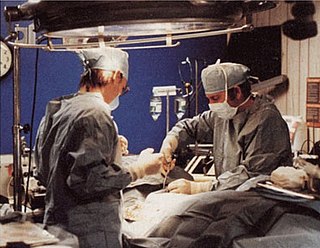
Cryonics is the low-temperature freezing and storage of human remains, with the speculative hope that resurrection may be possible in the future. Cryonics is regarded with skepticism within the mainstream scientific community. It is generally viewed as a pseudoscience, and its practice has been characterized as quackery.
Cryobiology is the branch of biology that studies the effects of low temperatures on living things within Earth's cryosphere or in science. The word cryobiology is derived from the Greek words κρῧος [kryos], "cold", βίος [bios], "life", and λόγος [logos], "word". In practice, cryobiology is the study of biological material or systems at temperatures below normal. Materials or systems studied may include proteins, cells, tissues, organs, or whole organisms. Temperatures may range from moderately hypothermic conditions to cryogenic temperatures.
Vitrification is the full or partial transformation of a substance into a glass, that is to say, a non-crystalline amorphous solid. Glasses differ from liquids structurally and glasses possess a higher degree of connectivity with the same Hausdorff dimensionality of bonds as crystals: dimH = 3. In the production of ceramics, vitrification is responsible for their impermeability to water.
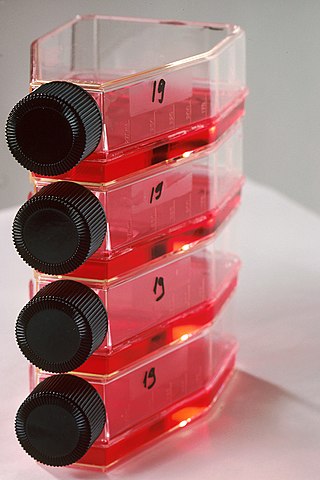
Tissue culture is the growth of tissues or cells in an artificial medium separate from the parent organism. This technique is also called micropropagation. This is typically facilitated via use of a liquid, semi-solid, or solid growth medium, such as broth or agar. Tissue culture commonly refers to the culture of animal cells and tissues, with the more specific term plant tissue culture being used for plants. The term "tissue culture" was coined by American pathologist Montrose Thomas Burrows. This is possible only in certain conditions. It also requires more attention. It can be done only in genetic labs with various chemicals.

Germplasm refers to genetic resources such as seeds, tissues, and DNA sequences that are maintained for the purpose of animal and plant breeding, conservation efforts, agriculture, and other research uses. These resources may take the form of seed collections stored in seed banks, trees growing in nurseries, animal breeding lines maintained in animal breeding programs or gene banks. Germplasm collections can range from collections of wild species to elite, domesticated breeding lines that have undergone extensive human selection. Germplasm collection is important for the maintenance of biological diversity, food security, and conservation efforts.
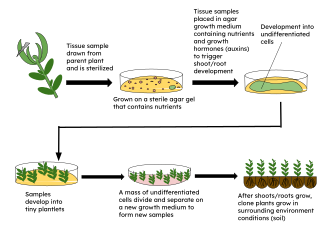
Micropropagation or tissue culture is the practice of rapidly multiplying plant stock material to produce many progeny plants, using modern plant tissue culture methods.
A cryoprotectant is a substance used to protect biological tissue from freezing damage. Arctic and Antarctic insects, fish and amphibians create cryoprotectants in their bodies to minimize freezing damage during cold winter periods. Cryoprotectants are also used to preserve living materials in the study of biology and to preserve food products.

A gene bank is a type of biorepository that is designed around the preservation of genetic information. Gene banks are often used for storing the genetic material of species that are endangered or close to extinction. They are also used for the preservation of major crop species and cultivars, in order to preserve crop diversity.

Oocyte cryopreservation is a procedure to preserve a woman's eggs (oocytes). This technique has been used to postpone pregnancy. When pregnancy is desired, the eggs can be thawed, fertilized, and transferred to the uterus as embryos. Several studies have shown that most infertility problems are due to germ cell deterioration related to aging. The procedure's success rate varies depending on the age of the woman,, as well as depending on health and genetic indicators. In 1986, the first human birth of oocyte oocyte cryopreservation was reported.

Cryopreservation or cryoconservation is a process where biological material - cells, tissues, or organs - are frozen to preserve the material for an extended period of time. At low temperatures any cell metabolism which might cause damage to the biological material in question is effectively stopped. Cryopreservation is an effective way to transport biological samples over long distances, store samples for prolonged periods of time, and create a bank of samples for users. Molecules, referred to as cryoprotective agents (CPAs), are added to reduce the osmotic shock and physical stresses cells undergo in the freezing process. Some cryoprotective agents used in research are inspired by plants and animals in nature that have unique cold tolerance to survive harsh winters, including: trees, wood frogs, and tardigrades.The first human corpse to be frozen with the hope of future resurrection was James Bedford's, a few hours after his cancer-caused death in 1967.[15] Bedford's is the only cryonics corpse frozen before 1974 still frozen today.
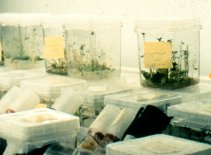
Plant tissue culture is a collection of techniques used to maintain or grow plant cells, tissues, or organs under sterile conditions on a nutrient culture medium of known composition. It is widely used to produce clones of a plant in a method known as micropropagation. Different techniques in plant tissue culture may offer certain advantages over traditional methods of propagation, including:
Crop diversity or crop biodiversity is the variety and variability of crops, plants used in agriculture, including their genetic and phenotypic characteristics. It is a subset of a specific element of agricultural biodiversity. Over the past 50 years, there has been a major decline in two components of crop diversity; genetic diversity within each crop and the number of species commonly grown.
Semen cryopreservation is a procedure to preserve sperm cells. Semen can be used successfully indefinitely after cryopreservation. It can be used for sperm donation where the recipient wants the treatment in a different time or place, or as a means of preserving fertility for men undergoing vasectomy or treatments that may compromise their fertility, such as chemotherapy, radiation therapy or surgery. It is also often used by trans women prior to medically transitioning in ways that affect fertility, such as feminizing hormone therapy and orchiectomies.
Cryopreservation of embryos is the process of preserving an embryo at sub-zero temperatures, generally at an embryogenesis stage corresponding to pre-implantation, that is, from fertilisation to the blastocyst stage.

Chrysanthemum × morifolium (also known in the US as florist's daisy and hardy garden mum, is a hybrid species of perennial plant in the genus Chrysanthemum of the Asteraceae family.

Cryoconservation of animal genetic resources is a strategy wherein samples of animal genetic materials are preserved cryogenically.
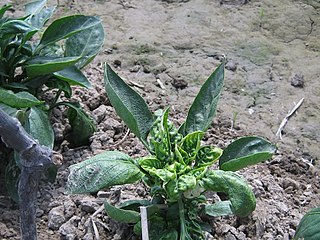
Pepper leaf curl virus(PepLCV) is a DNA virus from the genus Begomovirus and the family Geminiviridae. PepLCV causes severe disease especially in pepper (Capsicum spp.). It can be found in tropical and subtropical regions such as Thailand and India, but has also been detected in countries such as the United States and Nigeria. This virus is transmitted by an insect vector from the family Aleyrodidae and order Hemiptera, the whitefly Bemisia tabaci. The primary host for PepLCV are several Capsicum spp.. PepLCV has been responsible for several epidemics and causes severe economic losses. It is the focus of research trying to understand the genetic basis of resistance. Currently, a source of resistance to the virus has been identified in the Bhut Jolokia pepper.
Cryopreservation of testicular tissue is an experimental method being used to preserve fertility in pre-pubescent males, or males who cannot produce sperm, to allow them the option of having biological children.
References
- 1 2 3 Reed BM (2017-08-01). "Plant cryopreservation: a continuing requirement for food and ecosystem security". In Vitro Cellular & Developmental Biology - Plant. 53 (4): 285–288. doi: 10.1007/s11627-017-9851-4 . ISSN 1475-2689. S2CID 32177737.
- ↑ O'Brien C, Hiti-Bandaralage JC, Folgado R, Lahmeyer S, Hayward A, Mitter N (2020). "Developing a cryopreservation protocol for avocado ( Persea americana Mill.) apical shoot tips using different antioxidants". Acta Horticulturae (1285): 15–22. doi:10.17660/ActaHortic.2020.1285.3. ISSN 0567-7572. S2CID 226751510.
- ↑ Sopade PA, Samosir YM, Rival A, Adkins SW (December 2010). "Dehydration improves cryopreservation of coconut (Cocos nucifera L.)". Cryobiology. 61 (3): 289–96. doi:10.1016/j.cryobiol.2010.09.007. PMID 20959171.
- ↑ Panis B, Swennen R (1995). "Cryopreservation of Germplasm of Banana and Plantain (Musa Species)". Cryopreservation of Plant Germplasm I. Biotechnology in Agriculture and Forestry. Vol. 32. Berlin, Heidelberg: Springer Berlin Heidelberg. pp. 381–397. doi:10.1007/978-3-662-03096-7_27. ISBN 978-3-642-08184-2.
- 1 2 3 Wilms H, Fanega Sleziak N, Van der Auweraer M, Brands M, Verleije M, Hardeman D, et al. (7 September 2020). "Development of a fast and user-friendly cryopreservation protocol for sweet potato genetic resources". Scientific Reports. 10 (1): 14674. Bibcode:2020NatSR..1014674W. doi:10.1038/s41598-020-70869-3. PMC 7477159 . PMID 32895398.
- ↑ Zimnoch-Guzowska E., Chmielarz P., Wawrzyniak M.K., Plitta-Michalak B.P., Michalak M., Pałucka M., Wasileńczyk U., Kosek P., Kulus D., Rucińska A., Mikuła A., 2022. Polish cryobanks: research and conservation for plant genetic resources. Acta Societatis Botanicorum Poloniae 91: 9121. https://doi.org/10.5586/asbp.9121
- ↑ Kulus D., Zalewska M., 2014. Cryopreservation as a tool used in long-term storage of ornamental species – a review. Scientia Horticulturae 168: 88-107. https://doi.org/10.1016/j.scienta.2014.01.014
- ↑ da Silva RL, de Souza EH, de Jesus Vieira L, Pelacani CR, Souza FV (2017-05-17). "Cryopreservation of pollen of wild pineapple accessions". Scientia Horticulturae. 219: 326–334. doi:10.1016/j.scienta.2017.03.022. ISSN 0304-4238.
- ↑ Kartha KK (1982). In vitro growth responses and plant regeneration from cryopreserved meristems of cassava (Manihot esculenta Crantz)*). Casilla de Correos 209, Corrientes (3400) Argentina.: Facultad de Ciencias Agrarias, Instituto de Botanica del Nordeste. OCLC 709654438.
{{cite book}}: CS1 maint: location (link) - 1 2 3 Panis B, Piette B, Swennen R (2005-01-01). "Droplet vitrification of apical meristems: a cryopreservation protocol applicable to all Musaceae". Plant Science. 168 (1): 45–55. doi:10.1016/j.plantsci.2004.07.022. ISSN 0168-9452.
- ↑ Kulus, D., Rewers, M., Serocka, M. et al. Cryopreservation by encapsulation-dehydration affects the vegetative growth of chrysanthemum but does not disturb its chimeric structure. Plant Cell Tiss Organ Cult 138, 153–166 (2019). https://doi.org/10.1007/s11240-019-01614-6
- ↑ Kulus, D. Shoot Tip Cryopreservation of Lamprocapnos spectabilis (L.) Fukuhara Using Different Approaches and Evaluation of Stability on the Molecular, Biochemical, and Plant Architecture Levels. Int. J. Mol. Sci. 2020, 21, 3901. https://doi.org/10.3390/ijms21113901
- ↑ Escobar RH, Mafla G, Roca WM (April 1997). "A methodology for recovering cassava plants from shoot tips maintained in liquid nitrogen". Plant Cell Reports. 16 (7): 474–478. doi:10.1007/s002990050263. PMID 30727635.
- ↑ Hu, Chun (2015), Liu, Yanze; Wang, Zhimin; Zhang, Junzeng (eds.), "Chrysanthemum morifolium Ramat 菊花 (Juhua, Florists Chrysanthemum)", Dietary Chinese Herbs: Chemistry, Pharmacology and Clinical Evidence, Vienna: Springer, pp. 681–691, doi:10.1007/978-3-211-99448-1_77, ISBN 978-3-211-99448-1 , retrieved 2020-11-03